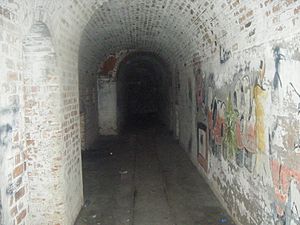Verne High Angle Battery facts for kids
The Verne High Angle Battery is an old military site from the 1800s. It's a type of gun battery located on the Isle of Portland in Dorset, England. This special place is near the Verne Citadel. It's so important that it's protected as a Grade II Listed building and is part of a larger historic monument. Today, the battery is a cool place for visitors to explore. Its underground tunnels are even known locally as the 'Ghost Tunnels'!
Contents
What is the Verne High Angle Battery?
The Verne High Angle Battery was a military fort built to protect Portland Harbour. It was designed to fire powerful guns at enemy ships. The name "high angle" means the guns shot shells high into the air. These shells would then drop almost straight down onto enemy ships. This method was very effective for damaging the weaker top parts of a ship.
Why Was the Battery Built?
The battery was constructed in 1892. Its main job was to defend the important Portland Harbour from attacks by sea. The harbour was a key naval base. Protecting it was very important for England's defense.
How Did the Battery Work?
The battery was built inside an old quarry. This clever design helped to hide the guns from enemy ships. The guns used were called RML 9 inch 12 ton guns. They were very large and powerful. These guns could turn all the way around, 360 degrees. This allowed them to aim at ships from any direction.
The battery had spots for six large guns. Later, two more gun pits were added, but no guns were ever placed there. The shells for the guns were kept safe in two underground tunnels. These tunnels were called magazines. Between the magazines, there was a shelter for soldiers, a laboratory, and other storage buildings.
When Was the Battery Used?
The Verne High Angle Battery was used for a short time. By 1906, new types of smaller, faster ships like torpedo boats were invented. These new boats were very hard for the large, slow-firing guns to hit. Because of this, the battery was no longer needed for its original purpose. It was officially taken out of service.
After 1906, the battery found new uses. From 1918, it was used to store field guns that came back from France after World War I. In the 1960s, one of the gun pits was even used for special tests. Scientists tested capsules there that were used to transport nuclear materials safely.



